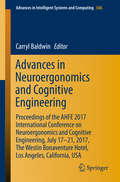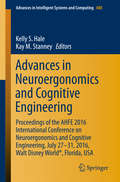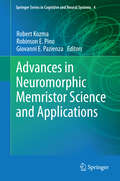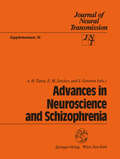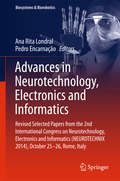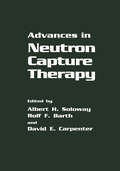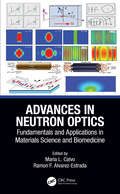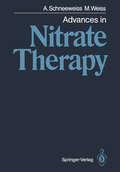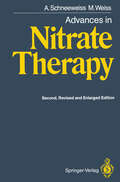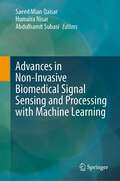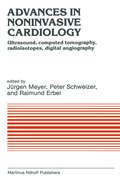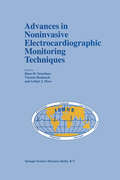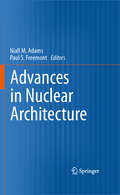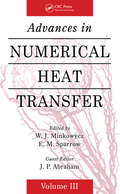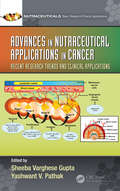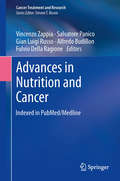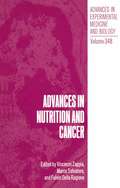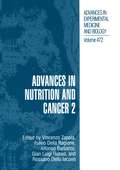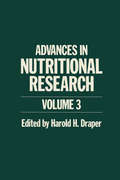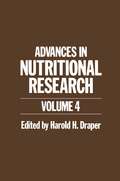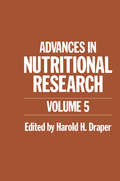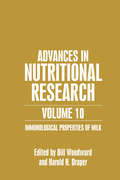- Table View
- List View
Advances in Neuroergonomics and Cognitive Engineering: Proceedings of the AHFE 2017 International Conference on Neuroergonomics and Cognitive Engineering, July 17–21, 2017, The Westin Bonaventure Hotel, Los Angeles, California, USA (Advances in Intelligent Systems and Computing #586)
by Carryl BaldwinThis book offers a broad perspective on the field of cognitive engineering and neuroergonomics, covering emerging practices and future trends toward the harmonious integration of human operators with computational systems. It reports on novel theoretical findings on mental workload and stress, activity theory, human reliability, error and risk, and neuroergonomic measures alike, together with a wealth of cutting-edge applications. Further, the book describes key advances in our understanding of cognitive processes, including mechanisms of perception, memory, reasoning, and motor response, with a special emphasis on their role in interactions between humans and other elements of computer-based systems. Based on the AHFE’s main track on Neuroergonomics and Cognitive Engineering, held on July 17–21, 2017 in Los Angeles, California, USA, it provides readers with a comprehensive overview of the current challenges in cognitive computing and factors influencing human performance.
Advances in Neuroergonomics and Cognitive Engineering: Proceedings of the AHFE 2016 International Conference on Neuroergonomics and Cognitive Engineering, July 27-31, 2016, Walt Disney World®, Florida, USA (Advances in Intelligent Systems and Computing #488)
by Kelly S. Hale Kay M. StanneyThis book offers a broad perspective on the field of cognitive engineering and neuroergonomics. It covers emerging practices and future trends towards the harmonious integration of human operators with computational systems. The book reports on novel theoretical findings on mental workload and stress, activity theory, human reliability, error and risk, and neuroergonomic measures alike, together with a wealth of cutting-edge applications. It describes key advances in the understanding of cognitive processes, including mechanisms of perception, memory, reasoning, and motor response, giving a special emphasis to their role in the interactions between humans and the other elements of a computer-based system. Based on the AHFE’s main track on Neuroergonomics and Cognitive Engineering, held on July 27-31, 2016 in Walt Disney World®, Florida, USA, the book provides readers with a comprehensive view of the current challenges in cognitive computing and factors influencing human performance.
Advances in Neuromorphic Memristor Science and Applications (Springer Series in Cognitive and Neural Systems #4)
by Robert Kozma, Robinson E. Pino and Giovanni E. PazienzaPhysical implementation of the memristor at industrial scale sparked the interest from various disciplines, ranging from physics, nanotechnology, electrical engineering, neuroscience, to intelligent robotics. As any promising new technology, it has raised hopes and questions; it is an extremely challenging task to live up to the high expectations and to devise revolutionary and feasible future applications for memristive devices. The possibility of gathering prominent scientists in the heart of the Silicon Valley given by the 2011 International Joint Conference on Neural Networks held in San Jose, CA, has offered us the unique opportunity of organizing a series of special events on the present status and future perspectives in neuromorphic memristor science. This book presents a selection of the remarkable contributions given by the leaders of the field and it may serve as inspiration and future reference to all researchers that want to explore the extraordinary possibilities given by this revolutionary concept.
Advances in Neuroscience and Schizophrenia (Journal of Neural Transmission. Supplementa #36)
by S. Gershon E. M. Stricker A. H. TumaSchizophrenia has been the subject of intense research interest in recent years, as investigators have explored the biological bases for the disorder and for various approaches to its diagnosis and treatment. This volume focuses on three aspects of such recent research connecting basic neuroscience to schizophrenia. In one, Professors Budinger, Gur, and Pettegrew provide critical reviews of brain imaging studies as they relate to cognitive behaviour functions in schizophrenia. In the second, Professors Goldmann-Rakic, Lewis, and Tassin discuss monoamine systems and their varied role in prefontal cortical circuitry and function. In the third, Professors Deutsch, Gerfen, and Grace discuss the structure, organization, and function of the basal ganglia, as they relate to schizophrenia and the mechanisms of neuroleptic action. These papers were presented at an interdisciplinary workshop on the subject at the University of Pittsburgh, in May 1991, and the discussion between the authors and other panelists in basic and clinical sciences are included in this volume as well. The presentation of these diverse approaches in an integrated fashion provides the reader with a unique perspective and a wealth of new questions for future collaborative research.
Advances in Neurotechnology, Electronics and Informatics: Revised Selected Papers from the 2nd International Congress on Neurotechnology, Electronics and Informatics (NEUROTECHNIX 2014), October 25-26, Rome, Italy (Biosystems & Biorobotics #12)
by Ana Rita Londral Pedro EncarnaçãoThis book is a timely report on current neurotechnology research. It presents a snapshot of the state of the art in the field, discusses current challenges and identifies new directions. The book includes a selection of extended and revised contributions presented at the 2nd International Congress on Neurotechnology, Electronics and Informatics (NEUROTECHNIX 2014), held October 25-26 in Rome, Italy. The chapters are varied: some report on novel theoretical methods for studying neuronal connectivity or neural system behaviour; others report on advanced technologies developed for similar purposes; while further contributions concern new engineering methods and technological tools supporting medical diagnosis and neurorehabilitation. All in all, this book provides graduate students, researchers and practitioners dealing with different aspects of neurotechnologies with a unified view of the field, thus fostering new ideas and research collaborations among groups from different disciplines.
Advances in Neutron Capture Therapy
by David E. Carpenter Rolf F. Barth Albert H. SolowayBinary systems for the treatment of cancer potentially are among the most attractive of the new therapeutic modalities that currently are under investigation. The basicconcept is to selectivelydestroy malignantcells whileconcomitantlysparing normal tissue. Neutron capture therapy (NCT) is the binary system that has been the subject of the Fifth International Symposium on Neutron Capture Therapy, which was held September13-17, 1992, in Columbus, Ohio, undertheauspicesoftheInternational Society for Neutron Capture Therapy. Its objective was to bring together researchers from throughout the world and to provide a forum at which they could present the latest advances in the development of Neutron capture therapy. Neutron capture therapy has largely, but not exclusively, focused on the use of boron-10 as the target nuclide. Boron neutron capture therapy (BNCT) is based on the nuclear reaction that occurs when the stable isotope, boron-10, absorbs low-energy non ionizing thermal neutrons to yield alphaparticles and recoiling lithium-7 nuclei. The size and energy of these high linear energy transfer (LET) particles result in their being confined largely to the cells in which the capture reaction occurs. For BNCT to be successful, a sufficient numberof I~atoms mustbe localized within neoplastic cells, and enough thermal neutrons must be delivered and absorbed by the I~ to produce a lethal 1~(n,QVLi reaction. Two major problems must be surmounted.
Advances in Neutron Optics: Fundamentals and Applications in Materials Science and Biomedicine (Multidisciplinary and Applied Optics)
by Maria L. Calvo Ramon F. Alvarez-EstradaNeutron optics studies the interactions of a beam of slow neutrons with matter. This book updates various advances on neutron optics. There will be a focus on the very active topics of neutron imaging (NI) and neutron spin optics (NSO). The book will also present applications of neutron beams in biomedicine, such as Boron Neutron Capture Therapy (BNCT) and related techniques. Features: Discusses diffraction and interference of slow neutrons, including computational approaches Reviews neutron imaging (NI) and neutron spin optics (NSO) Treats two major sources of slow neutron beams: (1) fission reactions at nuclear reactors and (2) collisions in particle accelerators (small ones, spallation sources) of charged particle beams with targets of heavy atoms Selects subjects on fundamental quantum aspects of slow neutrons and on confined propagation and waveguiding thereof Updates slow neutron beams and BNCT
Advances in Neutron Optics: Fundamentals and Applications in Materials Science and Biomedicine (Multidisciplinary and Applied Optics)
by Maria L. Calvo Ramon F. Alvarez-EstradaNeutron optics studies the interactions of a beam of slow neutrons with matter. This book updates various advances on neutron optics. There will be a focus on the very active topics of neutron imaging (NI) and neutron spin optics (NSO). The book will also present applications of neutron beams in biomedicine, such as Boron Neutron Capture Therapy (BNCT) and related techniques. Features: Discusses diffraction and interference of slow neutrons, including computational approaches Reviews neutron imaging (NI) and neutron spin optics (NSO) Treats two major sources of slow neutron beams: (1) fission reactions at nuclear reactors and (2) collisions in particle accelerators (small ones, spallation sources) of charged particle beams with targets of heavy atoms Selects subjects on fundamental quantum aspects of slow neutrons and on confined propagation and waveguiding thereof Updates slow neutron beams and BNCT
Advances in Nitrate Therapy
by Adam Schneeweiss Marija WeissAll aspects of nitrate therapy, including conventional and new formulations and delivery systems, are covered in this book. For each drug the formulation, mechanism of action, indications, effects, adverse reactions and special problems are systematically described. The use of nitrates in specific population groups, such as infants, children and the elderly, is dealt with separately. The book is updated, based not only on the world literature but also on the most recent conference presentations, and provides the reader with thorough and practice-oriented coverage.
Advances in Nitrate Therapy
by Adam Schneeweiss Marija WeissNitrates have been for many years the cornerstone of cardiovascular therapy for various indications. Not only have nitrates stood the test of time for treatment of chronic stable angina pectoris, but the indications for them have markedly ex panded. They now include all forms of angina pectoris and myocardial ischemia, congestive heart failure and hypertensive emergencies. The beneficial effects of nitrates in all these conditions result from their vasodilatory properties, but it is still unclear whether the central or peripheral effects predominate in the thera peutic mechanism. Recently nitrates have been shown to fulfill the most important requirement for each and every drug - to reduce mortality. A large scale study revealed that isosorbide dinitrate, combined with hydralazine, reduced long-term mortality by 28% in patients with congestive heart failure. This finding will certainly stimulate research on nitrates, and it might be expected that interest in these drugs will markedly increase. The primarily used nitrates in clinical practice are nitroglycerin and the com plex organic nitrates, mainly isosorbide dinitrate. The organic mononitrates are now under clinical investigation, and isosorbide-5-mononitrate (IS-5-MN) appears to be especially promising.
Advances in Non-Invasive Biomedical Signal Sensing and Processing with Machine Learning
by Saeed Mian Qaisar Humaira Nisar Abdulhamit SubasiThis book presents the modern technological advancements and revolutions in the biomedical sector. Progress in the contemporary sensing, Internet of Things (IoT) and machine learning algorithms and architectures have introduced new approaches in the mobile healthcare. A continuous observation of patients with critical health situation is required. It allows monitoring of their health status during daily life activities such as during sports, walking and sleeping. It is realizable by intelligently hybridizing the modern IoT framework, wireless biomedical implants and cloud computing. Such solutions are currently under development and in testing phases by healthcare and governmental institutions, research laboratories and biomedical companies. The biomedical signals such as electrocardiogram (ECG), electroencephalogram (EEG), Electromyography (EMG), phonocardiogram (PCG), Chronic Obstructive Pulmonary (COP), Electrooculography (EoG), photoplethysmography (PPG), and image modalities such as positron emission tomography (PET), magnetic resonance imaging (MRI) and computerized tomography (CT) are non-invasively acquired, measured, and processed via the biomedical sensors and gadgets. These signals and images represent the activities and conditions of human cardiovascular, neural, vision and cerebral systems. Multi-channel sensing of these signals and images with an appropriate granularity is required for an effective monitoring and diagnosis. It renders a big volume of data and its analysis is not feasible manually. Therefore, automated healthcare systems are in the process of evolution. These systems are mainly based on biomedical signal and image acquisition and sensing, preconditioning, features extraction and classification stages. The contemporary biomedical signal sensing, preconditioning, features extraction and intelligent machine and deep learning-based classification algorithms are described. Each chapter starts with the importance, problem statement and motivation. A self-sufficient description is provided. Therefore, each chapter can be read independently. To the best of the editors’ knowledge, this book is a comprehensive compilation on advances in non-invasive biomedical signal sensing and processing with machine and deep learning. We believe that theories, algorithms, realizations, applications, approaches, and challenges, which are presented in this book will have their impact and contribution in the design and development of modern and effective healthcare systems.
Advances in Noninvasive Cardiology: Ultrasound, computed tomography, radioisotopes, digital angiography (Developments in Cardiovascular Medicine #24)
by RaimundErbel PeterSchweizer JürgenMeyerAdvances in Noninvasive Electrocardiographic Monitoring Techniques (Developments in Cardiovascular Medicine #229)
by Arthur J. Moss VinzenzHombach Hans-H. OsterhuesNoninvasive electrocardiographic monitoring is a fundamental part of cardiology. Depending on continuous improvements and developments of new technologies, these methods are essential for diagnosis and risk stratification of patients. The rapid changes in the capabilities, technologies and diagnostic values of the different methods force us to update our knowledge continuously. This book offers a comprehensive overview of the current state and future developments in the field of noninvasive electrocardiographic monitoring techniques. In addition, related fields such as magnetocardiography, newer signal detection and analysis techniques as well as ambulatory blood pressure monitoring are reported. The different methods are discussed with regard to methodological aspects, latest technical developments and clinical value of results. Furthermore, review articles focus on the autonomic nervous system, monitoring of ischemic heart disease, quality control and standardization of monitoring techniques. A group of international experts in science and clinical practice have contributed to this book, which is supported by the International Society for Holter and Noninvasive Electrocardiography (ISHNE). The book is addressed to clinical and academic cardiologists as well as scientists.
Advances in Nuclear Architecture
by Niall M. Adams and Paul S. FreemontThis book provides a snapshot of the state-of-the art in the study of mammalian cell nuclear architecture, and features a diverse range of chapters written by top researchers. A key aspect is an emphasis on precise and repeatable quantitative analysis and simulation in addition to the more familiar biological perspective. The fusion of such material frames the future of the discipline. Quantitative contributions stress reproducible and robust 3D analysis, using a variety of tools ranging from point pattern analysis to shape registration methods. Biological insights include the role of nuclear subdomains in cancer, nuclear molecular motors, and a holistic view of gene transcription.
Advances in Numerical Heat Transfer, Volume 3
by W. J. MinkowyczDefinitive Treatment of the Numerical Simulation of Bioheat Transfer and Fluid FlowMotivated by the upwelling of current interest in subjects critical to human health, Advances in Numerical Heat Transfer, Volume 3 presents the latest information on bioheat and biofluid flow. Like its predecessors, this volume assembles a team of renowned internatio
Advances in Nutraceutical Applications in Cancer: Recent Research Trends and Clinical Applications (Nutraceuticals)
by Sheeba Varghese Gupta Yashwant V. PathakDietary supplements and nutraceuticals such as Vitamin A and D, Omega-3 and probiotics are used as part of the cancer treatment as complimenting the main therapy. Several Nutraceuticals have shown to boost the immune responses, while emerging clinical studies and other research suggests that some plant-based agents may, indeed, impact late-stage cancer, influencing molecular processes corrupted by tumor cells to evade detection, expand clonally, and invade surrounding tissues. Advances in Nutraceutical Applications in Cancer: Recent Research Trends and Clinical Applications is an attempt to collect evidence and related clinical information of application of Nutraceuticals to be used in cancer treatment or compliment the cancer treatment. It contains 16 chapters written by experts in related field’s and covers many different aspects of the formulation and development of Nutraceuticals for cancer applications. This book covers efficacy, safety and toxicological aspects of nutraceuticals. It also addresses various novel drug delivery systems of nutraceuticals with anticancer properties, as well as nutraceuticals as supplements for cancer prevention. Features: Offers a comprehensive view of neutraceuticals’ role in cancer prevention and treatment Covers the applications and implications of neutraceuticals in prostate, colorectal, breast and gynecological cancers Discusses the principles of neutrigenomics and neutrigenetics in cancer prevention Explors the role of probiotics and micronutrients in cancer treatment and prevention Nutraceuticals can alter the gut microbiota. Gut microbiome undergoes changes during the disease status and followed by the cancer treatment. Nutraceutical’s role in proliferation and prevention of gynecological cancers, nutraceutical’s role in proliferation and prevention of prostate cancer and role of micronutrients in cancer prevention, both pros and cons, are some of the topics discussed in various chapters in this book. This book is addressed to scientists, clinicians, and students who are working in the area of Nutraceutical applications in cancer treatment.
Advances in Nutraceutical Applications in Cancer: Recent Research Trends and Clinical Applications (Nutraceuticals)
by Sheeba Varghese Gupta Yashwant V. PathakDietary supplements and nutraceuticals such as Vitamin A and D, Omega-3 and probiotics are used as part of the cancer treatment as complimenting the main therapy. Several Nutraceuticals have shown to boost the immune responses, while emerging clinical studies and other research suggests that some plant-based agents may, indeed, impact late-stage cancer, influencing molecular processes corrupted by tumor cells to evade detection, expand clonally, and invade surrounding tissues. Advances in Nutraceutical Applications in Cancer: Recent Research Trends and Clinical Applications is an attempt to collect evidence and related clinical information of application of Nutraceuticals to be used in cancer treatment or compliment the cancer treatment. It contains 16 chapters written by experts in related field’s and covers many different aspects of the formulation and development of Nutraceuticals for cancer applications. This book covers efficacy, safety and toxicological aspects of nutraceuticals. It also addresses various novel drug delivery systems of nutraceuticals with anticancer properties, as well as nutraceuticals as supplements for cancer prevention. Features: Offers a comprehensive view of neutraceuticals’ role in cancer prevention and treatment Covers the applications and implications of neutraceuticals in prostate, colorectal, breast and gynecological cancers Discusses the principles of neutrigenomics and neutrigenetics in cancer prevention Explors the role of probiotics and micronutrients in cancer treatment and prevention Nutraceuticals can alter the gut microbiota. Gut microbiome undergoes changes during the disease status and followed by the cancer treatment. Nutraceutical’s role in proliferation and prevention of gynecological cancers, nutraceutical’s role in proliferation and prevention of prostate cancer and role of micronutrients in cancer prevention, both pros and cons, are some of the topics discussed in various chapters in this book. This book is addressed to scientists, clinicians, and students who are working in the area of Nutraceutical applications in cancer treatment.
Advances in Nutrition and Cancer (Cancer Treatment and Research #159)
by Vincenzo Zappia Salvatore Panico Gian Luigi Russo Alfredo Budillon Fulvio Della RagioneThis book comprises proceedings from the Third International Conference on Advances in Nutrition and Cancer, held in Naples in May 2012. This highly multidisciplinary meeting analyzed “nutrition and cancer” from different perspectives and on the basis of distinct and up-to-date experimental approaches. Knowledge on the relation between lifestyle, diet, and cancer is explored in a number of contributions, and the role of dietary intervention in cancer patients is discussed. Issues of vital interest to the research community, such as epidemiological and experimental oncology (genetics, epigenetics, and the mechanisms of action of natural compounds in the diet), receive detailed consideration. A further key topic is the emerging molecular technologies (the “omics”) that can cast light on the interplay between nutrition and human malignancies. Chapters take the form of reviews that include sections presenting expert opinions.
Advances in Nutrition and Cancer (Advances in Experimental Medicine and Biology #348)
by Vincenzo Zappia Marco Salvatore Fulvio Della RagioneThis volume contains the scientific contributions presented at the International Symposium held in Naples, Italy, in November 1992 at the National Tumor Institute "Fondazione Pascale". The Meeting gathered together experts from different disciplines, all involved in the vital and timely subject of Nutrition and Cancer. About 15 years ago a consensus among cancer epidemiologists began to emerge suggesting that diet might be responsible for 30-60% of the cancers in the developed world. The best estimate, reported in a now classical paper by Richard Doll and Richard Peto (1981), was that by dietary modification, it would be possible to reduce fatal cancers by about 35%. Within about six years there was widespread agreement that the principal changes required were a reduction in consumption of fat, along with an increase in the consumption of fruit, green and yellow vegetables, dietary fiber, and some micronutrients. Attention was also paid to the methods of cooking and preservation of foodstuffs. On the other hand very few, if any, effects were attributed to food additives and to pollution of food by trace pesticides, to which the general public often gives unfounded importance.
Advances in Nutrition and Cancer 2 (Advances in Experimental Medicine and Biology #472)
by Vincenzo ZappiaThis volume includes contributions presented at the Second International Sym posium on Nutrition and Cancer, held in Naples, Italy, in October 1998 at the National Tumor Institute "Fondazione Pascale." During the Conference, experts from different disciplines discussed pivotal and timely subjects on the interactions between human nutrition and the development of malignancies. Comparing the themes of this Meeting with those discussed at the First Sympo sium in 1992, the major scientific advancements certainly derive from the extensive use of molecular approaches to perform research in nutrition. Moreover, the fundamental observation of R. Doll and R. Peto (1981), which suggested that at least 35% of all cancers (with large differences among different tumors) might be prevented by dietary regimens, has been definitively confirmed by epidemiological studies. On the other hand, the relationships between diet and cancer are quite intricate and complex; it is difficult, and at the same time not methodologically correct, to reduce them to simple terms. Metabolic and hormonal factors, contaminants and biological agents, and deficiency of specific protective nutrients are all pieces of the same puzzle.
Advances in Nutritional Research
by H. DraperThe third volume of Advances in Nutritional Research continues the precedent set in previous volumes of providing authoritative reviews on the current state of knowledge with respect to major topics of ongoing nutritional research. This series is designed to be of value to investigators engaged in fundamental research as well as to those involved in its application to problems in human and animal nutrition. This volume contains three chapters on recent developments in research on inorganic elements, including a review, by F. H. Nielsen, of the evidence for a requirement for additional trace elements; a conspectus, by C. E. Casey and K. M. Hambidge, on the occurrence of trace element deficiencies in man; and a description, by M. Janghorbani and V. R. Young, of new methods of assessing the bioavailability of minerals in the diet. There are also three chapters on current topics of lipid research. One (by F. D. Sauer) is devoted to the cardiopathic effects of certain dietary monoenoic fatty acids, another (by C. Galli) to the influence of diet on prostaglandin synthesis, and the third (by H. 0. Bang and J. Dyerberg) to an analysis of the role of the unusual polyunsaturated fatty acids found in marine oils in the prevention of ischemic heart disease.
Advances in Nutritional Research (Advances in Nutritional Research #4)
by Harold H. DraperVolume 4 of Advances in Nutritional Research reflects the increased importance that recently has been attached to nutrition in many fields of clinical medicine. This heightened interest in nutrition stems from the demonstration that the intake of specific nutrients may have far-reaching consequences, not only for normal metabolism, but also for metabolic processes affecting clinical or subclinical disease. Conversely, many disease states have been shown to have previously unrecognized effects on nutrient function and metabolism. In addition to topics of obvious relevance to human clinical nutrition, this volume contains chapters dealing with the nutrition of cells grown in culture and of species that may provide insights into nutritional disorders of man. To gether with its predecessors, Volume 4 provides graduate students and estab lished investigators with authoritative accounts of the status of research on a range of topics of current interest in experimental and clinical nutrition. vii Contents Chapter 1. Vitamin-Responsive Genetic Abnormalities .......... . S. Harvey Mudd 1. Introduction.............................................. 1 2. Historical Perspective ...................................... 2 3. Genetic Abnormalities Currently Known to Be Vitamin Responsive. 3 4. Mechanisms Underlying Vitamin Responsiveness. . . . . . . . . . . . . . . . 7 4.1. Defects in the Processing of a Vitamin Prior to Its Interaction in Cofactor Form with a Particular Apoenzyme ........ 7 4.2. Defects in Particular Apoenzymes that Interact with the Cofactor Forms of Vitamins. . . . . . . . . . . . . . . . . . 16 . . . . . .
Advances in Nutritional Research: Volume 5 (Advances in Nutritional Research)
Volume 5 of Advances in Nutritional Research reflects a strong current interest in the relationship between nutrition and disease. The impact of disease on nutritional status is described for hepatic encephalopathy and cancer and for several ailments of hospitalized children. The impact of nutrition on disease is illustrated using the examples of retinol in tumorigenesis, vitamins A and E in inflammatory lung disease, fatty acids in atherogenesis and obesity, and folate in megaloblastic anemia. The contents will be of particular interest to clinicians and to students of nutritional biochemistry. vii Contents Chapter 1. Nutritional Management of Hepatic Encephalopathy ... Robert H. Bower and Josef E. Fischer 1. Introduction . . . . . . . . . . . . . . . . . . . . . . . . . . . . . . . . . . . . . . . . . . . . . . 1 2. The Nature of Hepatic Encephalopathy. . . . . . . . . . . . . . . . . . . . . . . . 2 2.1. The Ammonia Concept . . . . . . . . . . . . . . . . . . . . . . . . . . . . . . . 2 2.2. The Amino Acid Neurotransmitter Concept. . . . . . . . . . . . . . . 3 3. Nutritional Support in Hepatic Insufficiency. . . . . . . . . . . . . . . . . . . . 6 3. 1. Therapeutic Implications . . . . . . . . . . . . . . . . . . . . . . . . . . . . . . 6 3.2. Therapeutic Options. . . . . . . . . . . . . . . . . . . . . . . . . . . . . . . . . . 6 4. Experiments in Animals. . . . . . . . . . . . . . . . . . . . . . . . . . . . . . . . . . . . 7 5. Experience with Patients in Hepatic Encephalopathy . . . . . . . . . . . . . 7 5.1. Acute Hepatic Encephalopathy . . . . . . . . . . . . . . . . . . . . . . . . . 7 5.2. Chronic Hepatic Encephalopathy........................ 9 References . . . . . . . . . . . . . . . . . . . . . . . . . . . . . . . . . . . . . . . . . . . . . . . 9 Chapter 2. Cellular Retinol-and Retinoic Acid-Binding Proteins... 13 Frank Chytil and David E. Ong 1 . Introduction . . . . . . . . . . . . . . . . . . . . . . . . . . . . . . . . 13 . . . . . . . . . . . . . . 2. Cellular Retinol-and Retinoic Acid-Binding Proteins . . . . . . . . . . 13 . 2.1. Detection . . . . . . . . . . . . . . . . . . . . . . . . . . . . . . 14 . . . . . . . . . . . . 2.2. Characteristics . . . . . . . . . . . . . . . . . . . . . . . . . . . 15 . . . . . . . . . . . 3. Binding Proteins in Cultured Cells . . . . . . . . . . . . . . . . . . . . 19 . . . . . . . 4. Binding Proteins in Tumors. . . . . . . . . . . . . . . . . . . . . . . . 23 . . . . . . . . . 4.1. Binding Proteins in Experimental Tumors . . . . . . . . . . . . . 23 . . . 4.2. Binding Proteins in Human Tumors . . . . . . . . . . . . . . . . 23 . . . . . References . . . . . . . . . . . . . . . . . . . . . . . . . . . . . . . . . 26 . . . . . . . . . . . . . . ix x Contents Chapter 3. Nutrition and 3-Methylindole-lnduced Lung Injury . . . . . . . . . . . . . . . . . . . . . . . . . . . . . . . 31 . . . . . . . . . . . . . .
Advances in Nutritional Research Volume 10: Immunological Properties of Milk (Advances in Nutritional Research #10)
by Bill Woodward Harold H. DraperThis volume of Advances in Nutritional Research focuses on colostrum and milk as agents of defense against infection both for the suckling offspring and for the lactating mammary gland. The scope of the volume includes positive and negative influences of the consumption of mother's milk on the risk of infec tion, immunobiological roles of individual milk components, activities of milk and its components in promoting development of neonatal immunocompetence, the potential of milk and its components as therapeutic agents and as functional foods that support immune competence, and external influences that determine the immunological activity of milk. The volume is intended to provide a critical assessment of the limits of available information pertaining to humans and animals, together with authoritative comment regarding newer directions and unproven ideas. Part I provides a foundation for the volume. Readers unfamiliar with immunology will find, in Chapter 1, a selective outline of the anatomy and ontogeny of the mammalian immune system and of the types and regulation of immune defenses in mammals. Some emphasis is given to the place of the mammary gland within the common mucosal defense system, and to important species peculiarities in this regard. Chapter 2 is an authoritative and forward looking perspective on the development of knowledge pertaining to the immuno biology of milk as a fluid with both anti-infectious and anti-inflammatory roles. The chapter poses the provocative possibility of a tolerogenic role for milk.
Advances in Ocular Imaging in Glaucoma (Essentials in Ophthalmology)
by Rohit Varma Benjamin Y. Xu Grace M. Richter Alena ReznikServing as a practical guide to the ocular imaging modalities that are currently available to eye care providers for the care of glaucoma patients, this book provides information on advances in ocular imaging and their applications in the diagnosis and management of glaucoma. Each chapter introduces the imaging modality, highlight its strengths and weaknesses for clinical care, and discuss its integration into the clinical examination and decision-making process. The chapters also provide an in-depth description of the interpretation of images from each imaging modality. When appropriate, the chapters will summarize past and ongoing research and propose future research directions and clinical applications. This title will appeal to ophthalmologists and optometrists at all levels, from trainees to experienced clinicians looking to learn new and important information.
